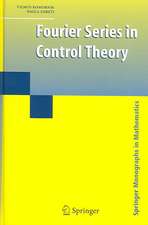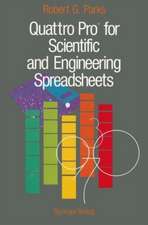Complex Networks and Their Applications XI: Proceedings of The Eleventh International Conference on Complex Networks and Their Applications: COMPLEX NETWORKS 2022 — Volume 1: Studies in Computational Intelligence, cartea 1077
Editat de Hocine Cherifi, Rosario Nunzio Mantegna, Luis M. Rocha, Chantal Cherifi, Salvatore Miccichèen Limba Engleză Hardback – 4 ian 2023
| Toate formatele și edițiile | Preț | Express |
|---|---|---|
| Paperback (1) | 2487.57 lei 6-8 săpt. | |
| Springer International Publishing – 5 ian 2024 | 2487.57 lei 6-8 săpt. | |
| Hardback (1) | 2493.90 lei 6-8 săpt. | |
| Springer International Publishing – 4 ian 2023 | 2493.90 lei 6-8 săpt. |
Din seria Studies in Computational Intelligence
- 20%
 Preț: 449.37 lei
Preț: 449.37 lei - 20%
 Preț: 1158.26 lei
Preț: 1158.26 lei - 20%
 Preț: 986.66 lei
Preț: 986.66 lei - 20%
 Preț: 1452.76 lei
Preț: 1452.76 lei - 20%
 Preț: 168.78 lei
Preț: 168.78 lei - 20%
 Preț: 1291.10 lei
Preț: 1291.10 lei - 18%
 Preț: 1112.30 lei
Preț: 1112.30 lei - 20%
 Preț: 565.39 lei
Preț: 565.39 lei - 20%
 Preț: 649.28 lei
Preț: 649.28 lei - 20%
 Preț: 1047.73 lei
Preț: 1047.73 lei - 20%
 Preț: 1578.96 lei
Preț: 1578.96 lei - 20%
 Preț: 643.50 lei
Preț: 643.50 lei - 20%
 Preț: 657.49 lei
Preț: 657.49 lei - 20%
 Preț: 993.28 lei
Preț: 993.28 lei - 20%
 Preț: 990.80 lei
Preț: 990.80 lei - 20%
 Preț: 989.96 lei
Preț: 989.96 lei - 20%
 Preț: 1165.69 lei
Preț: 1165.69 lei - 20%
 Preț: 1444.52 lei
Preț: 1444.52 lei - 20%
 Preț: 1041.96 lei
Preț: 1041.96 lei - 20%
 Preț: 1047.73 lei
Preț: 1047.73 lei - 20%
 Preț: 1046.06 lei
Preț: 1046.06 lei - 18%
 Preț: 2500.50 lei
Preț: 2500.50 lei - 20%
 Preț: 989.13 lei
Preț: 989.13 lei - 20%
 Preț: 1165.69 lei
Preț: 1165.69 lei - 20%
 Preț: 1164.05 lei
Preț: 1164.05 lei - 20%
 Preț: 1042.79 lei
Preț: 1042.79 lei - 20%
 Preț: 1460.19 lei
Preț: 1460.19 lei - 18%
 Preț: 1403.52 lei
Preț: 1403.52 lei - 18%
 Preț: 1124.92 lei
Preț: 1124.92 lei - 20%
 Preț: 1039.47 lei
Preț: 1039.47 lei - 20%
 Preț: 1008.11 lei
Preț: 1008.11 lei - 20%
 Preț: 1045.25 lei
Preț: 1045.25 lei - 20%
 Preț: 1275.42 lei
Preț: 1275.42 lei - 20%
 Preț: 1040.32 lei
Preț: 1040.32 lei - 20%
 Preț: 988.32 lei
Preț: 988.32 lei - 20%
 Preț: 1169.79 lei
Preț: 1169.79 lei - 20%
 Preț: 1162.37 lei
Preț: 1162.37 lei - 20%
 Preț: 1059.26 lei
Preț: 1059.26 lei - 20%
 Preț: 1164.05 lei
Preț: 1164.05 lei - 20%
 Preț: 1166.52 lei
Preț: 1166.52 lei - 20%
 Preț: 1459.38 lei
Preț: 1459.38 lei - 18%
 Preț: 1005.74 lei
Preț: 1005.74 lei - 20%
 Preț: 997.38 lei
Preț: 997.38 lei - 20%
 Preț: 1055.94 lei
Preț: 1055.94 lei - 20%
 Preț: 1284.47 lei
Preț: 1284.47 lei - 20%
 Preț: 994.08 lei
Preț: 994.08 lei - 20%
 Preț: 1048.72 lei
Preț: 1048.72 lei - 20%
 Preț: 1066.02 lei
Preț: 1066.02 lei - 20%
 Preț: 943.78 lei
Preț: 943.78 lei - 20%
 Preț: 1173.10 lei
Preț: 1173.10 lei
Preț: 2493.90 lei
Preț vechi: 3041.34 lei
-18% Nou
Puncte Express: 3741
Preț estimativ în valută:
477.26€ • 518.24$ • 400.90£
477.26€ • 518.24$ • 400.90£
Carte tipărită la comandă
Livrare economică 23 aprilie-07 mai
Preluare comenzi: 021 569.72.76
Specificații
ISBN-13: 9783031211263
ISBN-10: 303121126X
Pagini: 653
Ilustrații: XXV, 653 p. 228 illus., 191 illus. in color.
Dimensiuni: 155 x 235 mm
Greutate: 1.13 kg
Ediția:1st ed. 2023
Editura: Springer International Publishing
Colecția Springer
Seria Studies in Computational Intelligence
Locul publicării:Cham, Switzerland
ISBN-10: 303121126X
Pagini: 653
Ilustrații: XXV, 653 p. 228 illus., 191 illus. in color.
Dimensiuni: 155 x 235 mm
Greutate: 1.13 kg
Ediția:1st ed. 2023
Editura: Springer International Publishing
Colecția Springer
Seria Studies in Computational Intelligence
Locul publicării:Cham, Switzerland
Cuprins
Part I: Information Spreading in Social Media.- Cognitive Cascades within Media Ecosystems: Simulating Fragmentation, Selective Exposure and Media Tactics to Investigate Polarization.- Properties of Reddit News Topical Interactions.- Will You Take the Knee? Italian Twitter Echo Chambers’ Genesis during EURO 2020.- A simple model of knowledge scaffolding.- Using knowledge graphs to detect partisanship in online political discourse.- The wisdom_of_crowds: an efficient, philosophically-validated, social epistemological network profiling toolkit.- Opening up echo chambers via optimal content recommendation.- Change my Mind: Data Driven Estimate of Open-Mindedness from Political Discussions.- The effects of message sorting in the diffusion of information in online social media.- Gradual Network Sparsification and Georeferencing for Location-Aware Event Detection in Microblogging Services.- Manipulation during the French presidential campaign : Coordinated inauthentic behaviors and astroturfing analysis on text and images.- Part II: Modeling Human Behavior.- Lexical networks constructed to correspond students’ short written responses: A quantum semantic approach.- Attributed Stream-Hypernetwork analysis: Homophilic Behaviors in Pairwise and Group Political Discussions on Reddit.- Individual Fairness for Social Media Influencers.- Multidimensional online American politics: Mining emergent social cleavages in social graphs.- Classical and quantum random walks to identify leaders in criminal networks.- Random walk for generalization in goal-directed human navigation on Wikipedia.- Sometimes Less is More: When Aggregating Networks Masks Effects.- An Adaptive Network Model Simulating the Effects of Different Culture Types and Leader Qualities on Mistake Handling and Organisational Learning.- Part III: Biological Networks.- Modeling of Hardy-Weinberg Equilibrium using dynamic random networks in an ABM framework.- IntegrOmics: A computational Framework to analyze RNA-Seq and Methylation data through heterogeneous multi-layer networks.- A Network-based Approach for Inferring Thresholds in Co-expression Networks.- Building Differential Co-expression Networks with Variable Selection and Regularization.- Inferring probabilistic Boolean networks from steady-state gene data samples.- Quantifying High-Order Interactions in Complex Physiological Networks: a frequency-specific approach.- A Novel Reverse Engineering Approach for Gene Regulatory Networks.- Using the Duplication-Divergence Network Model to Predict Protein-Protein Interactions.- Part IV: Machine Learning and Networks.- SignedS2V: structural embedding method for signed networks.- HM-LDM: A Hybrid-Membership Latent Distance Model.- The Structure of Interdisciplinary Science: Uncovering and Explaining Roles in Citation Graphs.- Inferring Parsimonious Coupling Statistics in Nonlinear Dynamics with Variational Gaussian Processes.- Detection of Sparsity in Multidimensional Data Using Network Degree Distributionand Improved Supervised Learning with Correction of Data Weighting.- Network Structure vs Chemical Information in Drug-Drug Interaction Prediction.- Geometric Deep Learning graph pruning to speed-up the run-time of Maximum Clique Enumerarion algorithms.- Graph Mining and Machine Learning for Shader Codes Analysis to Accelerate GPU Tuning.- Part V: Networks in Finance and Economics.- Pattern Analysis of Money Flows in the Bitcoin Blockchain.- On the Empirical Association between Trade Network Complexity and Global Gross Domestic Product.- Measuring the Stability of Technical Cooperation Network Based on the Nested Structure Theory.- Dynamic transition graph for estimating the predictability of financial and economical processes.- A network analysis of world trade structural changes (1996-2019).- Green Sector Space: The evolution and capabilities spillover of economic green sectors in the United States.- Statistical inference of lead-lag between asynchronous time series from p-values oftransfer entropy at various timescales.- Part VI: Networks and Mobility.- Extracting Metro Passenger Flow Predictors from Network’s Complex Characteristics.- Estimating Peak-Hour Urban Traffic Congestion.- Adaptive Routing Potential in Road Networks.- Part VII: Diffusion and Epidemics.- Detecting Global Community Structure in a COVID-19 Activity Correlation Network.- Overcoming vaccine hesitancy by multiplex social network targeting.- Analyzing Community-aware Centrality Measures Using The Independent Cascade Model.- Paths for emergence of superspreaders in dengue fever spreading network.- Part VIII: Multilayer Networks.- Structural Cores and Problems of Vulnerability of Partially Overlapped Multilayer Networks.- Multilayer Block Models for Exploratory Analysis of Computer Event Logs.- On the Effectiveness of Using Link Weights and Link Direction for Community Detection in Multilayer Networks.
Textul de pe ultima copertă
This book highlights cutting-edge research in the field of network science, offering scientists, researchers, students, and practitioners a unique update on the latest advances in theory and a multitude of applications. It presents the peer-reviewed proceedings of the XI International Conference on Complex Networks and their Applications (COMPLEX NETWORKS 2022). The carefully selected papers cover a wide range of theoretical topics such as network models and measures; community structure, network dynamics; diffusion, epidemics, and spreading processes; resilience and control as well as all the main network applications, including social and political networks; networks in finance and economics; biological and neuroscience networks and technological networks.
Caracteristici
Presents the latest research in complex networks and their applications Gathers the edited proceedings of the Eleventh International Workshop on Complex Networks & their Applications Offers state-of-the-art research on complex networks, including various research directions





























